The Marine Big Five – Africa’s Icons of the Deep
Written by
Ker & Downey® Africa
South Africa is an ancient land that abounds with iconic wildlife. It comes as no surprise then that witnessing the impressive Big Five (lion, leopard, African elephant, buffalo and rhinoceros) tops many a bucket list for travelers to the nation.
However, if you think that the extraordinary, natural beauty ends with these iconic creatures, you would be mistaken. Even more spectacular animals await to be discovered… underwater. The coastal waters of South Africa accommodate a rich diversity of species of which five spectacular marine fauna make up the most notable. Known as the Marine Big Five, they are the great white shark, the southern right whale, the bottlenose dolphin, the Cape fur seal, and the African penguin.
The term Marine Big Five originated in South Africa and observing these prolific species in their natural habitat is nothing short of awe inspiring. Although sightings are not guaranteed, there are a few destinations along the coast that will give you the best opportunity to witness and spend time with them. These include the Western Cape coastal region, Gansbaai and the Southern Peninsula.
Talk to one of our expert LuxVenture® designers today about some of our recommended destinations that deliver the best Marine Big Five experiences on the coast of South Africa, and come face-to-face with these icons of the deep.
Great White Shark
The remarkable great white shark sits on top of the marine food chain, and for good reason. Adult sharks can reach between four and a half and six meters in length, weighing in at around two and a half tons and swimming at speeds of up to 15 miles per hour. With approximately 300 sharp, regenerative serrated teeth, these highly selective hunters have been documented feeding on a variety of fish species, dolphins and seals.
Current research suggests that great white sharks are intelligent and highly inquisitive creatures. When they gather in numbers, they have been seen displaying different behaviors, from assertive body slams to open-mouthed gaping at one another. Despite being feared by most around the world, these fantastic beasts are classified as endangered and need protection from extinction. Getting up close and personal to this apex predator is without a doubt one of the most riveting wildlife encounters on the planet.
The coastal region of the Western Cape is one of the best locations to see these ancient creatures, and at close range. Particular hotspots include Seal Island in Mossel Bay and Dyer Island near Gansbaai.
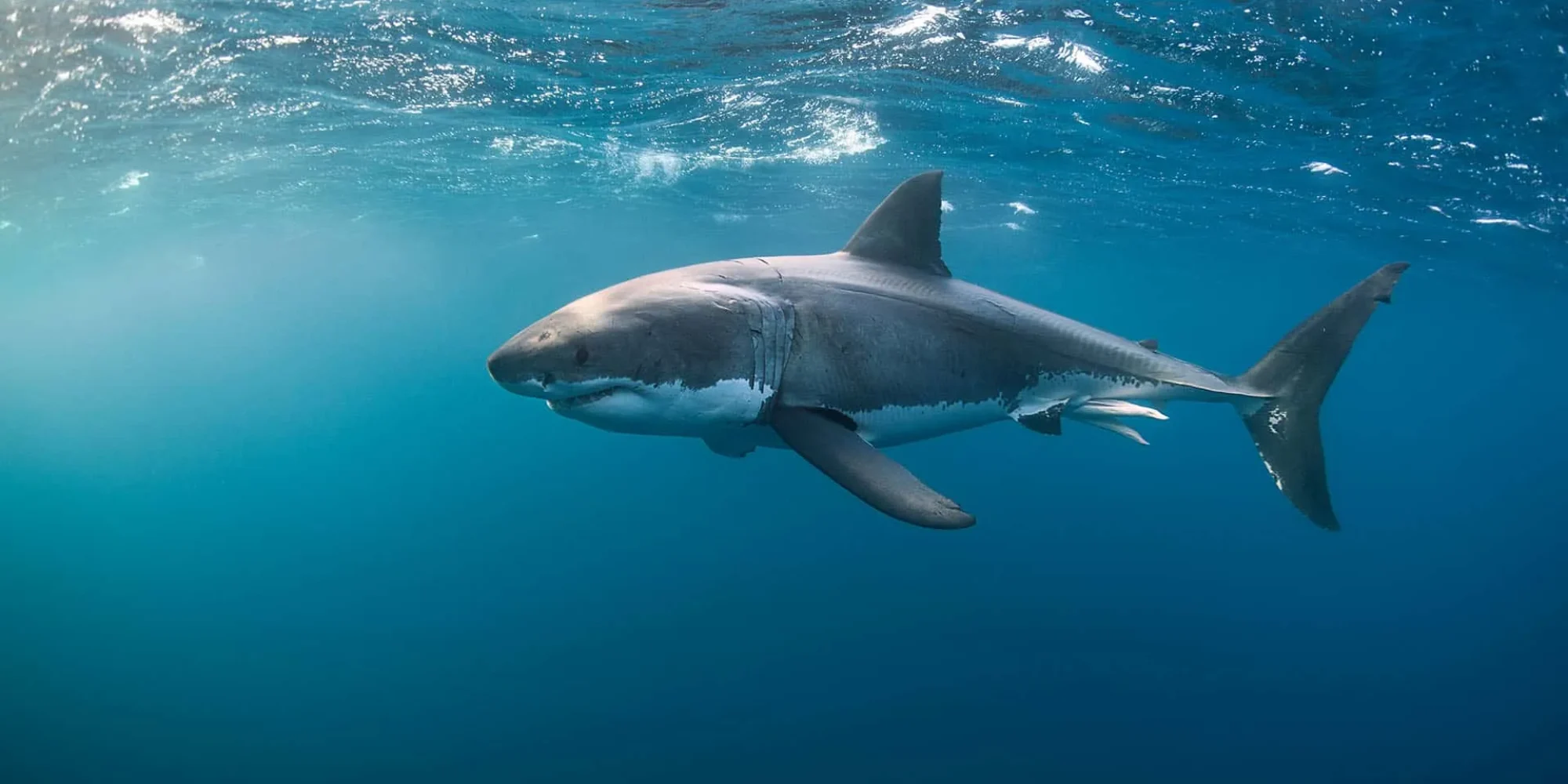
The iconic great white shark is the largest predatory fish on Earth
Southern Right Whale
Southern right whales are the rarest of all the large whale species and were named as such by whalers who identified them as the “right” whales to hunt. One of the largest animals on the planet, these giants of the deep love to wave their fins and bob their tails, leaving those who are lucky enough to witness their antics awe-struck. If you are really lucky, you may even witness these 16-meter long, 60 ton ocean giants breaching out of the water, leaving colossal splashes in their wake.
Each whale dons characteristic calluses on various parts of their head. These features function like fingerprints and help identify individuals throughout their life. Every year, hundreds of whales leave the icy waters of the Antarctic and migrate to the warmer coastal waters of South Africa during the Southern Hemisphere’s winter season. It is during this time that locations such as the coastal town of Hermanus become prime land-based whale watching spots, where one can enjoy seven miles of cliff path to view these magnificent animals from close range.
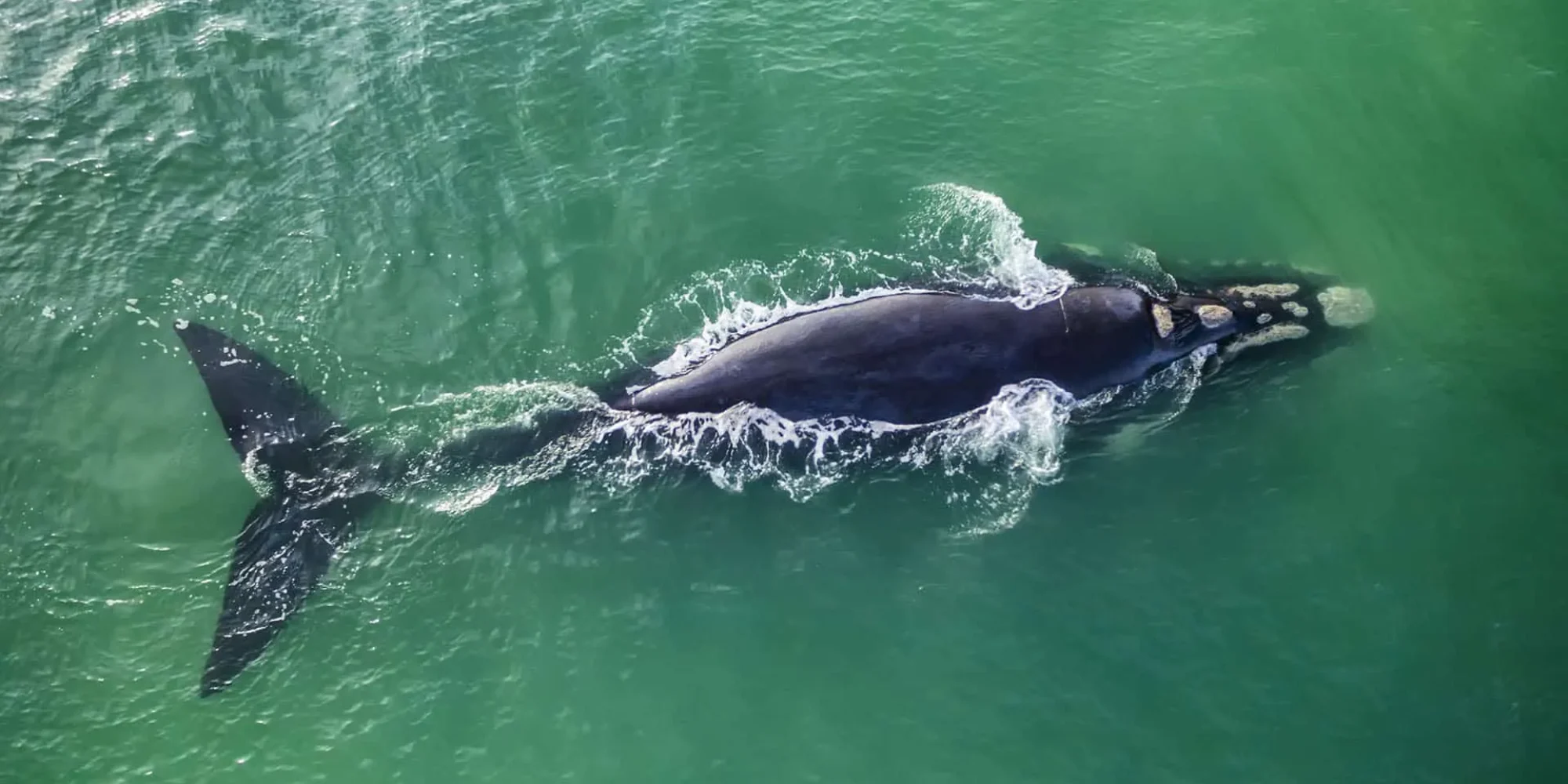
A large southern right whale swimming in open water
Bottlenose Dolphin
Indo-Pacific bottlenose dolphins are frequent visitors to the South African coastline. These playful creatures can be found in pods of five to 15, although there have been records of so-called superpods reaching a staggering 600 individuals! They remain in the area of their birth throughout their lifetime and often approach the boats and paddlers that have ventured out to find them.
Highly intelligent and inquisitive, bottlenose dolphins seem to delight in playing, splashing and surfing in the wake of boats and seek to satisfy their curiosity about humans. It is therefore no surprise that no other marine animal inspires as much elation and joy as they caper through the water. Simon’s Town and False Bay in Cape Town provide adequate views of these stunning animals. Another popular dolphin-watching destination is Plettenberg Bay along the Garden Route but for a truly adventurous spectacle, one can follow massive pods of dolphins during the annual sardine run. Along the east coast of South Africa, they follow and feast on the immense migration of silvery pilchards.
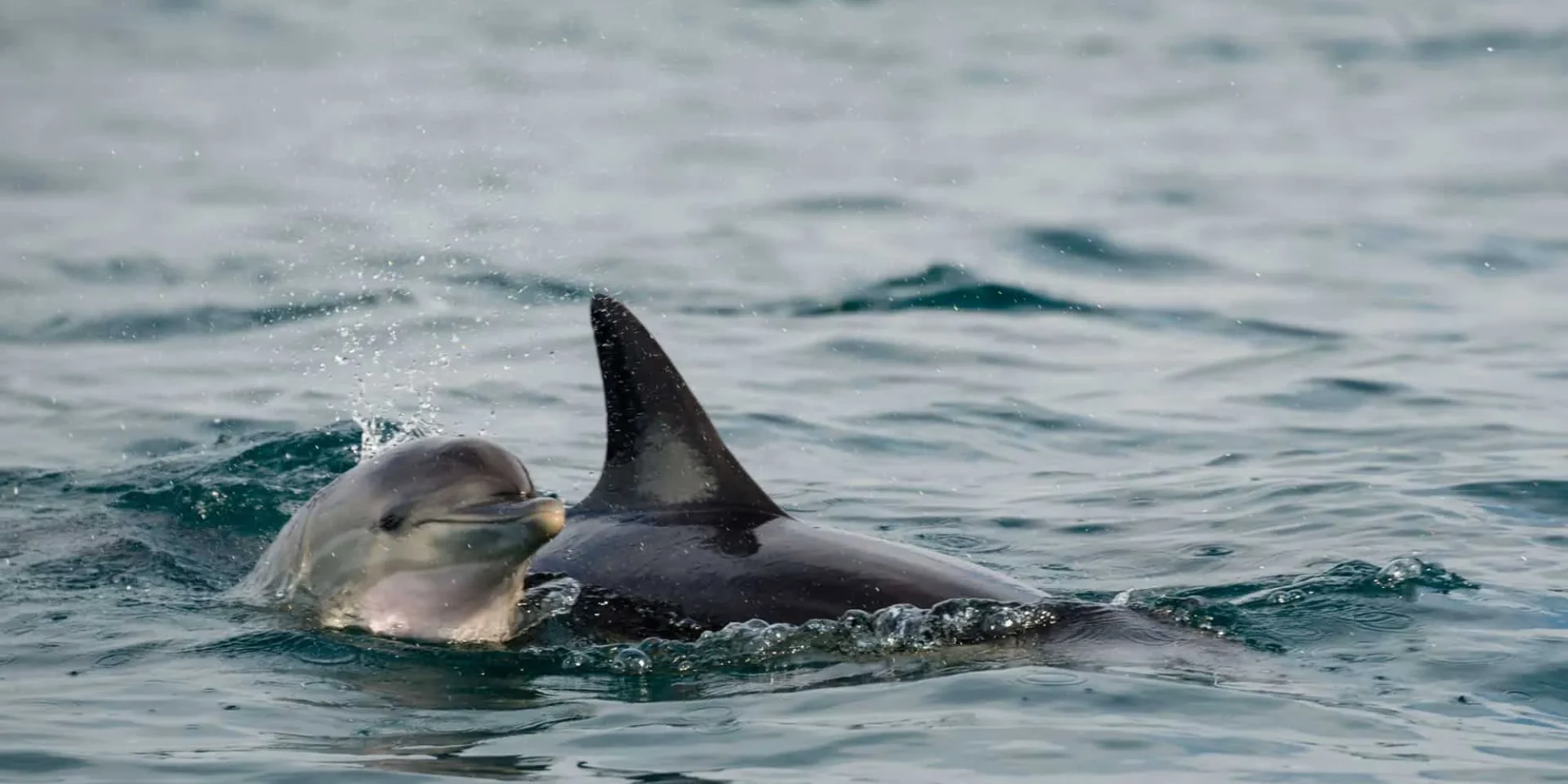
Highly intelligent and inquisitive, bottlenose dolphins seem to delight in playing, splashing and surfing in the wake of boats and seek to satisfy their curiosity about humans.
Cape Fur Seal
There is something comical about the Cape fur seal. Sociable and frisky, they are the only resident seal species in South Africa. These warm-blooded creatures are able to regulate their body temperatures in the icy cold Benguela current that runs along the Skeleton Coast and Western Cape coast. Because of this, they are able to spend at least 30% of every month at sea.
Pensive on land, these aquatic mammals were built for the deep blue, and it is only when they grace the water that you experience their agility, speed and playfulness. They can dive to depths of over 400 meters and stay submerged for between seven and ten minutes at a time. Large eyes enable them to see both forward and sideways, which is a unique advantage when it comes to both hunting and avoiding being hunted. These seals attract many tourists at Hout Bay and Kalk Bay harbors in Cape Town but, for a truly adventurous experience, one can dive with them in the Karbonkelberg marine protected area that forms part of the Table Mountain National Park.
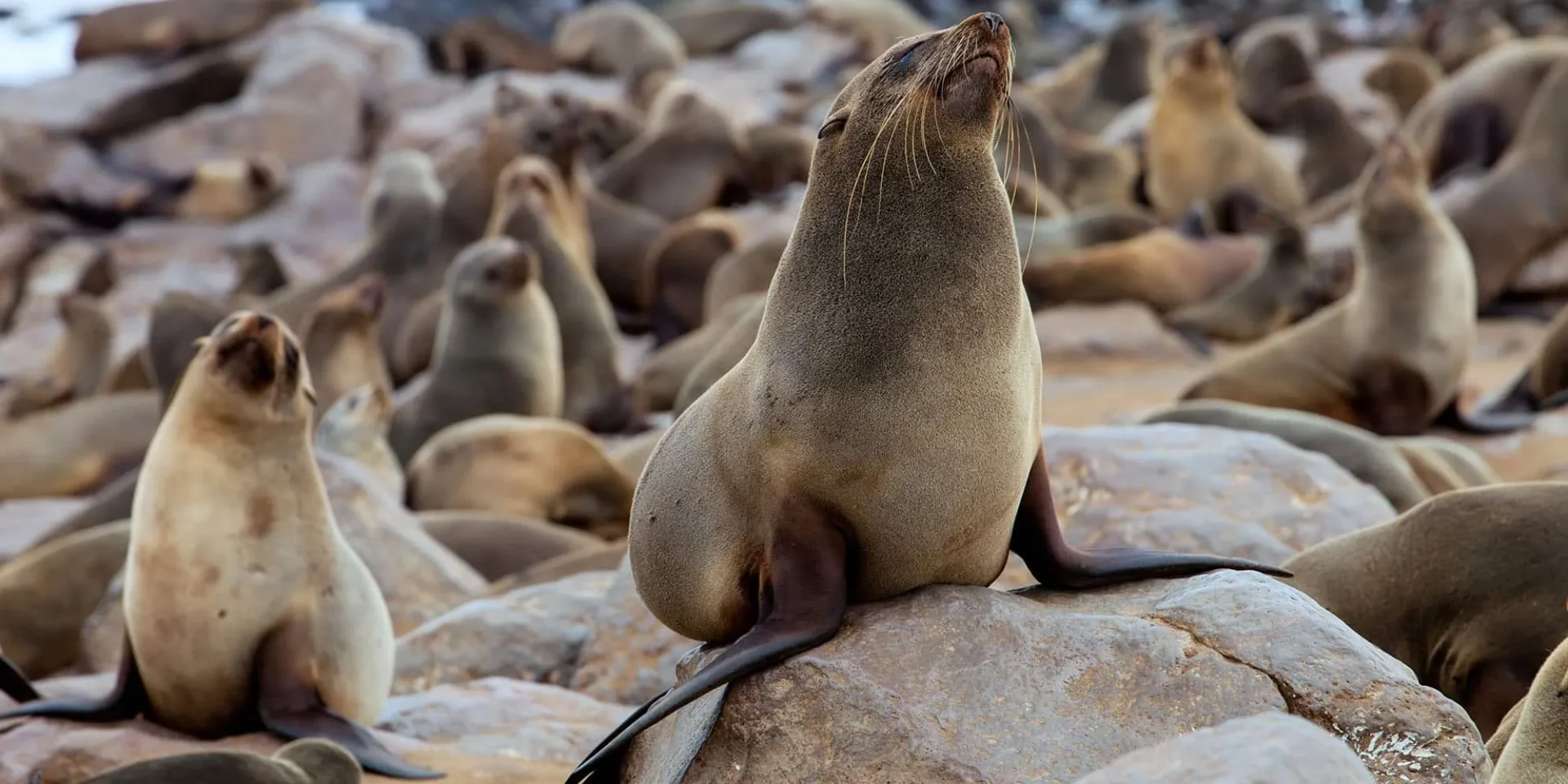
Pensive on land, these aquatic mammals were built for the deep blue, and it is only when they grace the water that you experience their agility, speed and playfulness.
African Penguin
The African penguin is endemic to Namibia and South Africa. These cute and diminutive marine animals can grow up to 70 centimeters tall and weigh between five and 11 pounds. Males are larger than females and also possess larger beaks. They make up for their clumsiness on land in the water, where they are particularly brisk and agile, reaching speeds of up to 12 miles per hour. Also known as Jackass penguins, they often outperform the likes of seals and dolphins in the water, making any sighting of them a special one.
The African penguin is now considered an endangered species, with all breeding sites being protected. For an intimate experience with this member of the marine Big Five, you can visit the colonies at Boulders Beach in Simon’s Town, Cape Town or in the offbeat, small town of Betty’s Bay at Stony Point. Witnessing the shenanigans of these unique, monogamous birds will surely be a highlight of any visit to Western Cape coast.
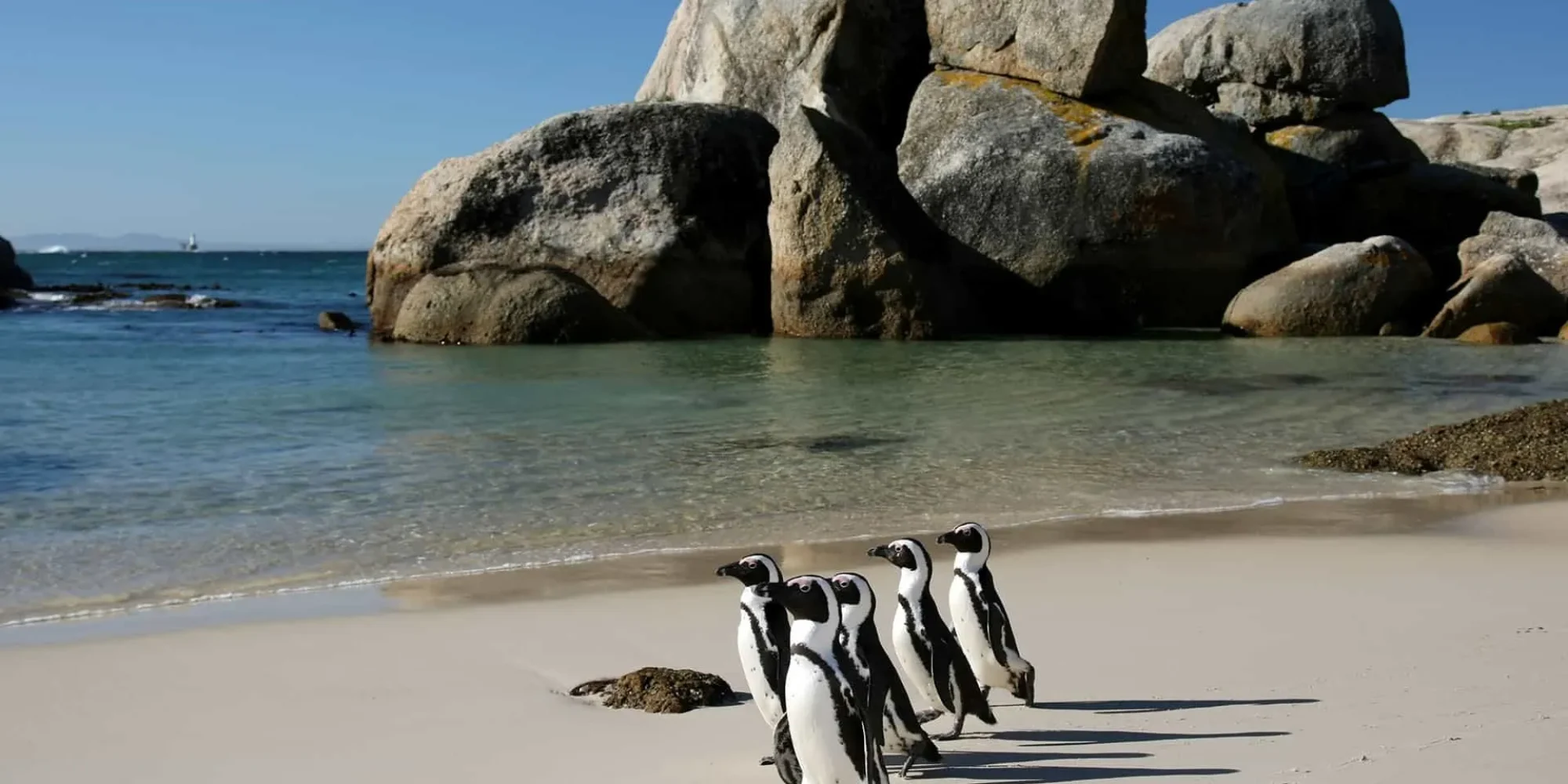
Witnessing the shenanigans of these unique, monogamous birds will surely be a highlight of any visit to Western Cape coast.
The African penguin is now considered an endangered species, with all breeding sites being protected. For an intimate experience with this member of the marine Big Five, you can visit the colonies at Boulders Beach in Simon’s Town, Cape Town or in the offbeat, small town of Betty’s Bay at Stony Point. Witnessing the shenanigans of these unique, monogamous birds will surely be a highlight of any visit to Western Cape coast.
Curated Packages
Signature journeys across Africa
Our expert team crafts journeys that transcend luxury. Each itinerary is shaped by the spirit of the land and the wisdom of its people — opening doors to experiences few can imagine, and even fewer will ever access.
15 June - 15 November
|
7 DAYS
Luxury Tented Safari in Tanzania
From
per person
All Year Round
|
10 DAYS
Cairo + Luxury Nile Cruise
From
per person
All Year Round
|
11 DAYS
Cape Town Safari & Whale Coast Adventure
From
per person
June-October
|
10 DAYS
Electric Vehicle Safari in Kenya
From
per person
Dec – Mar
|
7 DAYS
Wildebeest Calving Season Safari
From
per person
All Year Round
|
10 DAYS
Tanzania & Zanzibar Family Holiday
From
per person
March to June
|
10 DAYS
Zimbabwe Victoria Falls & Safari LuxVenture®
From
per person
All Year Round
|
12 DAYS
Tanzania & Zanzibar Honeymoon Safari
From
per person
June-February
|
13 DAYS
A Cultural Safari Tanzania Zanzibar
From
per person
May-October
|
8 DAYS
Luxury Treehouse Safari to Botswana LuxVenture®
From
per person
Year Round
|
18 DAYS
Southern Africa Luxury Bush & Beach Escape
From
per person
All Year Round
|
11 DAYS
Luxury Egypt Experience
From
per person
Jan, Feb, Jun – Sept
|
5 DAYS
Mountain Gorilla Trekking in Rwanda
From
per person
All Year Round
|
9 DAYS
Botswana Okavango Honeymoon LuxVenture®
From
per person
All Year Round
|
11 DAYS
Luxury Safari in Zambia
From
per person
All Year Round
|
9 DAYS
‘Out of Africa’ Safari in Kenya
From
per person
June - Sept
|
15 DAYS
Gorillas & Big Five Safari Adventure
From
per person
All year round
|
12 DAYS
Luxury Family Safari: South Africa & Victoria Falls
From
per person
All Year Round
|
16 DAYS
Ultimate East Africa Safari
From
per person
All Year Round
|
13 DAYS
Amboseli, Lewa and Masai Mara Safari
From
per person
All Year Round
|
13 DAYS
Elephant Safari in South Africa, Victoria Falls & Botswana
From
per person
Year Round
|
11 DAYS
Luxury Seychelles Honeymoon and Couples Vacation
From
per person
June - Sept
|
8 DAYS
Rivers & Rainforests: A Ugandan Safari
From
per person
All Year Round
|
12 DAYS
Stargazing Desert Safari in Namibia
From
per person
All Year Round
|
17 DAYS
Luxury Mauritius & South Africa Experience
From
per person
June-October
|
7 DAYS
African Wild Dog Safari
From
per person
All Year Round
|
12 DAYS
Culinary Journey to Morocco
From
per person
All Year Round
|
7 DAYS
Luxury Gorilla Trekking Safari in Rwanda
From
per person
March-December
|
10 DAYS
Luxury Private Safari in Zambia
From
per person
All Year Round
|
8 DAYS
Best of Egypt LuxVenture®
From
per person
All Year Round
|
7 DAYS
Chobe River Cruise & Okavango Delta Safari
From
per person
Year Round
|
15 DAYS
The Ultimate Southern Africa Bush & Beach
From
per person
All Year Round
|
17 DAYS
Southern Africa: Framed and Untamed
From
per person
All year round
|
9 DAYS
Beaches of Seychelles Vacation
From
per person
July-September
|
6 DAYS
Horseback Safari in Kenya
From
per person
Year Round
|
10 DAYS
Natural East Africa Wonders Safari
From
per person
All Year Round
|
10 DAYS
Luxury Tanzania Honeymoon LuxVenture®
From
per person
All Year Round
|
8 DAYS
Luxury Kenya Safari
From
per person
May to October
|
8 DAYS
Mad Max Safari Adventure
From
per person
Jan, Feb, Jun – Sept
|
13 DAYS
Gorilla Trekking, Ngorongoro Crater & Serengeti
From
per person
All Year Round
|
8 DAYS
Fly-in Luxury Namibia Safari
From
per person
June-August
|
12 DAYS
Rovos Rail and Zambezi River Escape
From
per person
Feb – May, Sep – Dec
|
10 DAYS
Luxury Journey Through Morocco
From
per person
June – October
|
18 DAYS
Tanzania and Seychelles Luxury Safari
From
per person
All Year Round
|
14 DAYS
Luxury South Africa and Mozambique Honeymoon
From
per person
May to October | November to April
|
11 DAYS
Spirit of Zambia Safari
From
per person
All Year Round
|
14 DAYS
Southern Africa’s Finest: SA, Victoria Falls & Botswana
From
per person
All year round
|
9 DAYS
9-day Victoria Falls to Botswana Luxury Safari
From
per person
All Year Round
|
12 DAYS
South Africa Art, Wine & Wilderness Safari
From
per person
June-October
|
8 DAYS
Tanzania Northern Circuit Safari
From
per person
All Year Round
|
10 DAYS
Botswana & Victoria Falls Adventure
From
per person
June-October
|
9 DAYS
Sub Saharan Kenya Safari Experience
From
per person
April-October
|
10 DAYS
Best of Botswana Safari
From
per person
All Year Round
|
9 DAYS
Luxury Adventure through Namibia
From
per person
Year Round
|
8 DAYS
African Wild Dog Safari in Zimbabwe
From
per person
June - Sept
|
11 DAYS
Uganda Done Right
From
per person
All Year Round
|
Day Trip to Antarctica LuxVenture®
From
per person
All Year Round
|
6 DAYS
Luxury Morocco Vacation
From
per person
May-October
|
10 DAYS
South Luangwa Walking Safari
From
per person
June-October
|
9 DAYS
The Great Wildebeest Migration Safari in Tanzania
From
per person
All Year Round
|
9 DAYS
Luxury Safari in Kruger National Park & Cape Town
From
per person